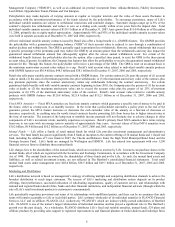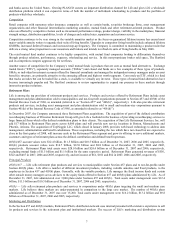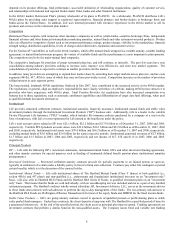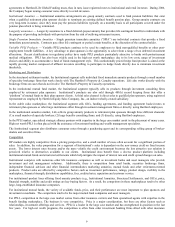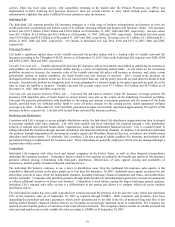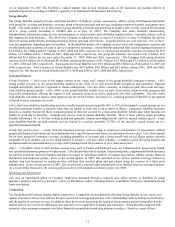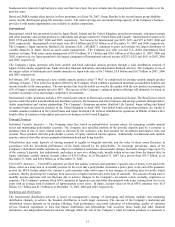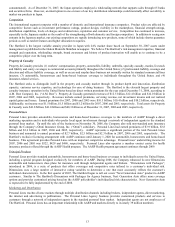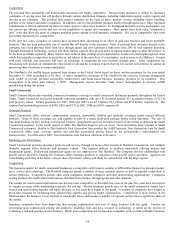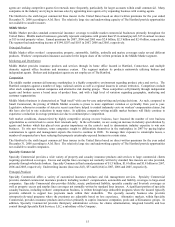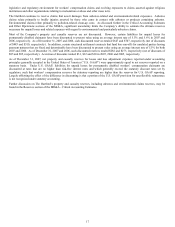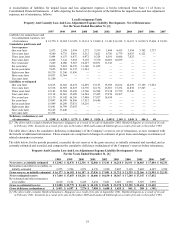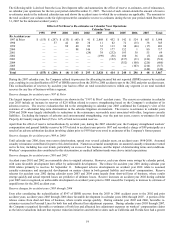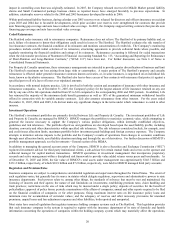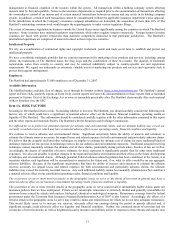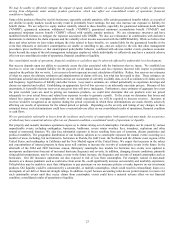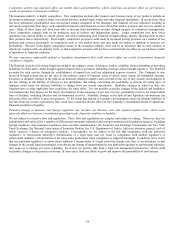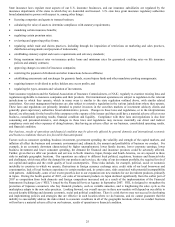The Hartford 2007 Annual Report Download - page 16
Download and view the complete annual report
Please find page 16 of the 2007 The Hartford annual report below. You can navigate through the pages in the report by either clicking on the pages listed below, or by using the keyword search tool below to find specific information within the annual report.
16
Marketing and Distribution
Specialty Commercial provides insurance products and services through its home office located in Hartford, Connecticut and multiple
domestic office locations. The segment markets its products nationwide utilizing a variety of distribution networks including
independent retail agents, brokers and wholesalers. Brokers, independents agents and wholesalers are not employees of The Hartford.
Competition
Specialty Commercial is comprised of a diverse group of businesses that operate independently within their specific industries. These
businesses, while somewhat interrelated, have different business models and operating cycles. Specialty Commercial is considered a
transactional business and, therefore, competes with other companies for business primarily on an account by account basis due to the
complex nature of each transaction.
For specialty casualty business, written pricing competition continues to be significant, particularly for the larger individual accounts.
Written pricing declines and expanded terms and conditions have reduced the profitability of this business. Carriers are trying to
protect their in-force casualty business by starting to renew policies well before the policy renewal date. Employing this early renewal
practice often prevents other carriers from quoting on the business, resulting in fewer new business opportunities within the
marketplace. With national account business, as the market continues to soften, policyholders are retaining less of the risk themselves
as carriers are selling more policies with lower deductibles and selling more guaranteed cost policies in place of loss-sensitive products.
The market for loss sensitive casualty business in 2008 will likely continue to experience written pricing declines and the use of
expanded terms and conditions. For property business, written pricing on catastrophe business continues to be under pressure due to
competition from both traditional markets and new entrants.
For professional liability business, we expect 2008 to be another year of written pricing decreases and easing of terms and conditions
due to an increase in underwriting capacity and the decline in federal shareholder class action lawsuits up until the fourth quarter of
2007. Carriers writing professional liability business are focused more on profitable private, middle market companies, with multi-year
programs becoming more common. For commercial surety business, favorable underwriting results within the past couple of years has
led to more intense competition for market share. This could lead to written price declines and less favorable terms and conditions.
Driven by the upheaval in the credit markets, new private construction activity has declined and may continue to decline, resulting in
lower demand for contract surety business.
Disciplined underwriting and targeted returns are the objectives of Specialty Commercial since premium writings may fluctuate based
on the segment’ s view of perceived market opportunity. Specialty Commercial competes with other stock companies, mutual
companies, alternative risk sharing groups and other underwriting organizations. The relatively large size and underwriting capacity of
The Hartford provide opportunities not available to smaller companies.
Other Operations
The Other Operations segment operates under a single management structure, Heritage Holdings, which is responsible for two related
activities. The first activity is the management of certain subsidiaries and operations of The Hartford that have discontinued writing
new business. The second is the management of claims (and the associated reserves) related to asbestos, environmental and other
exposures.
Life Reserves
Life insurance subsidiaries of the Company establish and carry as liabilities, predominantly, three types of reserves: (1) a liability equal
to the balance that accrues to the benefit of the policyholder as of the financial statement date, otherwise known as the account value,
(2) a liability for unpaid losses, including those that have been incurred but not yet reported, and (3) a liability for future policy benefits,
representing the present value of future benefits to be paid to or on behalf of policyholders less the present value of future net
premiums. The liabilities for unpaid losses and future policy benefits are calculated based on actuarially recognized methods using
morbidity and mortality tables, which are modified to reflect Life’ s actual experience when appropriate. Liabilities for unpaid losses
include estimates of amounts to fully settle known reported claims as well as claims related to insured events that the Company
estimates have been incurred but have not yet been reported. Future policy benefit reserves are computed at amounts that, with
additions from estimated net premiums to be received and with interest on such reserves compounded annually at certain assumed rates,
are expected to be sufficient to meet Life’ s policy obligations at their maturities or in the event of an insured’ s disability or death.
Other insurance liabilities include those for unearned premiums and benefits in excess of account value. Reserves for assumed
reinsurance are computed in a manner that is comparable to direct insurance reserves.
Property & Casualty Reserves
The Hartford establishes property and casualty reserves to provide for the estimated costs of paying claims under insurance policies
written by The Hartford. These reserves include estimates for both claims that have been reported to The Hartford and those that have
been incurred but not reported (“IBNR”) and include estimates of all expenses associated with processing and settling these claims.
This estimation process involves a variety of actuarial techniques and is primarily based on historical experience and consideration of
current trends. Examples of current trends include increases in medical cost inflation rates, the changing use of medical care
procedures, the introduction of new products such as the Dimensions product in Personal Lines and the Next Generation auto product in
Personal Lines, Small Commercial and Middle Market. Other current trends include changes in internal claim practices, changes in the


